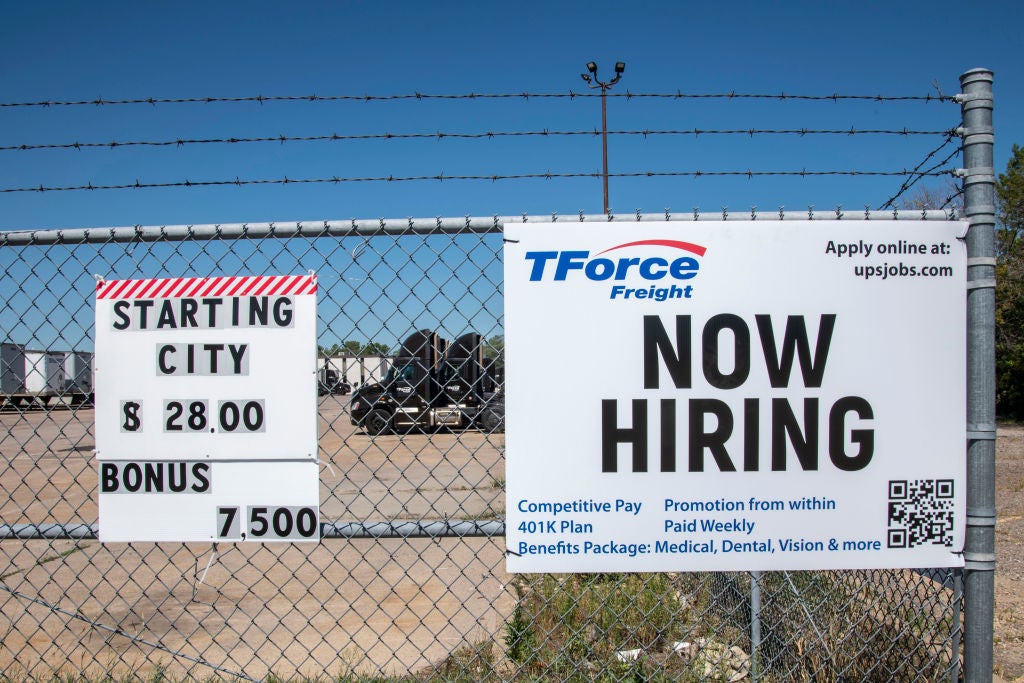
Something strange is happening in the labour market.
A study by the London School of Economics found that half of all UK businesses have been experiencing labour shortages in recent months, with one in five having issues even retaining their current staff.
The same government elected on a mandate of cutting immigration through leaving the EU has been forced to introduce a temporary visa programme to attract workers in the hardest-hit industries, including poultry workers and HGV drivers.
Businesses in the US are reporting similar shortages. Companies ranging from Domino’s pizza chain, to FedEx, to HCA Healthcare have reported struggling with a lack of workers.
As of September 2021, there were just 1.2 unemployed people per vacancy in the UK, the lowest figure on record. In the US, the ratio has fallen to just 0.7 – also the lowest on record. In other words, there are 1.4 jobs seeking workers for every worker seeking a job.
And yet, in neither country is the ratio of job seekers to jobs all that much lower than it was before the pandemic struck.
How well do you really know your competitors?
Access the most comprehensive Company Profiles on the market, powered by GlobalData. Save hours of research. Gain competitive edge.

Thank you!
Your download email will arrive shortly
Not ready to buy yet? Download a free sample
We are confident about the unique quality of our Company Profiles. However, we want you to make the most beneficial decision for your business, so we offer a free sample that you can download by submitting the below form
By GlobalDataIn the UK, the ratio of job seekers to job openings was hovering around 1.6 in the two years preceding the pandemic, having fallen from an average of 5.2 over the period 2011–13. Just 10% of the total tightening seen since then has occurred during the course of the pandemic.
The same is true in the US, where the unemployed-to-vacancy ratio stood at 0.8 pre-pandemic, compared with 0.7 today. That is down from a peak of 6.5 in July 2009 and an average of 3.4 during the 2011–13 period, meaning just 4% of the total tightening since 2011–13 has taken place during the pandemic.
What has caused the labour shortage problem?
If the labour market is not all that much tighter than before the pandemic, why do labour shortages appear to be such a problem?
One possible explanation is that the pandemic has created or exacerbated a mismatch between job vacancies and the unemployed. There might be 1.4 jobs available for any given jobseeker in the US, but they are increasingly likely to be the wrong job – requiring the wrong skills, paying the wrong wage or simply being located in the wrong place.
The nature of the jobs on offer has indeed changed. Retail jobs accounted for 11% of UK vacancies before the pandemic struck, but are now just 7%. Jobs in education are down from 6% to 5%, and motor repair from 16.4% to 12.8%. By contrast, vacancies for jobs in the hospitality trade have risen from 11% to 14% of the total, and in manufacturing from 6.7% to 7.6%.
A September report by the Institute of Fiscal Studies examined the number of vacancies available for different types of worker, focusing on the types of jobs that people leaving their professions typically try to take up.
The report found that the surge in UK vacancies has been driven entirely by low-paying jobs, with the majority of workers actually facing reduced vacancies compared with pre-pandemic levels. For one-quarter of workers, vacancies in jobs relevant to them are down by 10% or more.
We might usually expect the labour market to resolve such problems on its own. This is a polite way of saying that employers complaining of labour shortages have a simple solution at their disposal – offer higher wages.
Some have done so. About one-third of UK companies have reported raising wages in response to the shortages. UK supermarket chain Tesco, for instance, has offered new HGV drivers a £1,000 bonus just for signing up. The same appears to be true in the US, where wages across the hospitality sector have surged.
There are several reasons why this might not be working as well as employers had hoped: fear of catching Covid-19, childcare responsibilities arising from school closures, a changed attitude to work-life balance, and a stimulus-fuelled safety net of personal savings.
One possible explanation, however, has remained underexplored – that workers simply don’t know how much wages have gone up.
Workers don't know their worth
In a recent study, researchers at the US National Bureau of Economic Research found that workers systematically underestimate the wages available to them elsewhere. Researchers Simon Jäger, Christopher Roth, Nina Roussille and Benjamin Schoefer surveyed German workers on their expected wage change if forced to switch to their next-best employer, and compared this with the typical wage change experienced by their co-workers when forced to change job.
The team found that workers tend to assume that their wages wouldn’t change much if forced to switch jobs, even though many of them could expect to see a significant boost in income. Expectations of potential earnings were found to be driven almost entirely by current earnings, as opposed to actual potential earnings.
The researchers estimate that between 10% and 17% of jobs would be unviable, on current wages, if workers had accurate beliefs about their outside options.
What does this mean for the labour shortage? If workers tend to underestimate the wages available on the job market, it is certainly possible that unemployed people might be underestimating the wages available in sectors they might previously have dismissed. Raising wages will be for nothing if the message doesn’t filter through.
What is clear is that there is no absolute shortage in terms of people looking for work. There is, however, clearly something interfering with the process of getting people looking for work into jobs. A skills mismatch is likely to be part of the explanation, but it isn’t something amenable to short-term fixes: it takes years of training to become a software developer or an HGV driver.
To the extent that the dysfunction in a market is a result of poor communication, however, there might be more room for short-term solutions.







